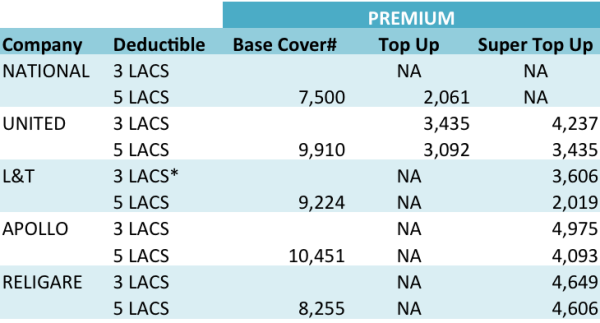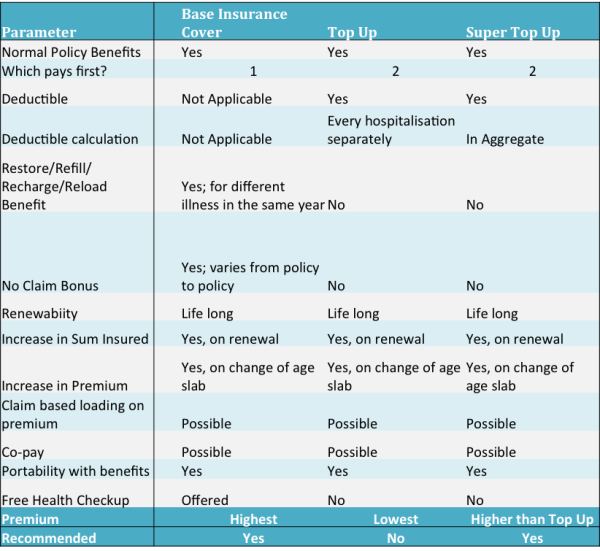In an earlier post I wrote about Health Insurance and what factors matter in selecting one. I compared 3 health insurance plans too – that of Apollo Munich, Max Bupa and Religare.
As you would understand by now, when you take a Health Insurance Policy, you are allowed to claim expenses against any medical treatments (as specified in the policy document) upto the amount of Sum Insured.
The question is what would happen if your medical expenses go beyond the Sum Insured. For example, you have a health insurance cover of Rs. 5 lacs. But for an unfortunate event that required hospitalisation, the medical bills ran upto Rs. 9 lacs.
Your health insurance would cover the expenses upto Rs. 5 lacs only. Where would you arrange the balance Rs. 4 lacs?
The simple answer is you would have to pay out of your own pocket, putting a dent in your finances.
Well, there is another solution to this problem. It is to buy a Top Up health insurance cover.
What exactly is a Top Up health insurance?
In the above example, if you had a top up health cover of say another Rs. 5 lacs, then the top up policy would have paid the balance Rs. 4 lacs. This would have saved you the personal financial setback.
A Top Up health insurance works almost like a normal insurance policy cover except that it gets triggered only after a particular level of expense.
You have to specify right at the beginning, when you take up a Top up cover, as to at what level do you want it to get triggered. A top up will pay you any expenses that happen over and above that level.
To revisit the previous example, you could have a top up that triggered after Rs. 5 lacs, which is the base insurance cover.
This level at Rs. 5 lacs is also called the ‘deductible’.
Simply put, you would have to arrange to pay all the expenses (either by yourself or another health cover that you have) till the deductible limit after which the Top Up heal insurance will take over.
“But why buy a top up? I can just increase the insured amount on my current health insurance.”
To answer this question, let’s understand the difference between a Normal health insurance cover and a Top up Health Insurance.
First, since a top up gets triggered only after a particular level or deductible, the risk to the insurer is that much less. This reflects in the premium charged too. A top up cover is available for far less a premium than a normal health insurance.
Second, a top up doesn’t offer features such as No Claim Bonus or more recent ones like Restore / Recharge. By offering lesser features, an insurer can charge a lesser premium to you.
So, the core argument for buying a top up is that you can buy additional insurance cover for a far lesser premium than a normal policy cover.
Let me give you a few instances.
A National Insurance Floater policy for Rs. 5 lacs for 2 adults with ages 36 and 35 costs an annual premium of Rs. 7,500 approximately.
For the same couple, a Top Up health insurance cover of another Rs. 5 lacs offered by United Insurance would come for an annual premium of Rs. 3,000.
Note: All premium amounts are mentioned exclusive of taxes.
Just to put things in perspective, the deductible in this case is Rs. 5 lacs, which is equal to the base policy cover. This Top Up would get triggered for expenses over and above Rs. 5 lacs.
A similar cover from L&T is available only at Rs. 1,763.
If the deductible is Rs. 3 lacs, for instance, the premium for the Top Up from United Insurance would be Rs. 3,700. The one from L&T would be Rs. 3,149.
As you would notice, lower the deductible, higher the premium.
The more important point to be noted is the comparative premium of a Normal Health Insurance and a Top Up Health Insurance.
Table of comparative premium between Base Cover, Top Up and Super Top Up Health Insurance
 # Base Cover is for Rs. 5 lacs floater policy for 2 Adults aged 36 and 35 years.
# Base Cover is for Rs. 5 lacs floater policy for 2 Adults aged 36 and 35 years.
*L&T Super top up with Rs. 3 lacs deductible has a Sum Insured of Rs. 7 lacs.
Now you see 3 columns in the above table – Base Cover, Top Up and Super Top Up.
The question you would ask is – what is a Super Top Up?
It is a Top Up with something extra. The biggest difference between a Top Up and a Super Top Up is the way they calculate the deductible amount – the base limit above which a Top Up gets triggered.
In case of a Top Up, each and every hospitalisation is treated as a separate instance and deductible is calculated for each of the instances.
Let us take an example here.
Suppose, you have a health insurance cover of Rs. 5 lacs and a Top Up of another Rs. 5 lacs.
Now for some unfortunate reason, you had to undergo multiple hospitalisations in a single policy year.
The first time, the expense bill came to Rs. 4 lacs. Since your base policy is for Rs. 5 lacs, all of it was paid from the base policy.
Now the second time, you got hospitalised, your expenses totalled to Rs. 3 lacs.
You would need to pay a little more attention here.
In this case, your base policy would pay you only Rs. 1 lac. Remember the first time you have already claimed Rs. 4 lacs out of the Sum Insured of Rs. 5 lacs.
Now you would expect that your top up health insurance would pay you the balance Rs. 2 lacs (out of Rs. 3 lacs bill). But that is not the case.
The way Top Up works is that it calculates the deductible afresh for every case. So even in the second instance, it would turn around and say “Hey, I would pay you only when your expenses exceed Rs. 5 lacs. That is the deductible we had agreed to. Since your bill in this case is only Rs. 3 lacs, I am not liable to pay anything.”
“Whoosh! What trickery” you might say. You see, that is how a top up works.
However, if you had a single hospitalisation where your medical bills totalled up to Rs. 7 lacs in one go, then in that case, your base policy would pay up Rs. 5 lacs. Post which the Top Up would get triggered and pay the balance Rs. 2 lacs.
In the same year, if you had another hospitalisation where the bills added up to Rs. 6 lacs, your base policy will pay you nothing, since you have already exhausted the Rs. 5 lacs cover. However, your Top Up will pay Rs. 1 lac (the amount over and above Rs. 5 lacs deductible).
Clear. Great!
Not so great actually. The idea of applying the deductible with every bill leaves you high and dry. The Top Up does not work for you fully.
But there is a way to get around this shortcoming.
Enter the Super Top Up
A super top up doesn’t look at every medical bill separately but as an aggregate.
As long as you have reached your deductible limit in aggregate, the super top up will pay.
To understand it simply, in the above example, assume you had a super top up of the same amount. Where the top up refused to pay out Rs. 2 lacs, the super top would have paid you.
Taking the above case further, if there was yet another hospitalisation in the same year and medical bills added upto Rs. 5 lacs, the base policy would have paid you nothing since you already exhausted the cover.
However, the super top up would have paid you Rs. 3 lacs. Why not the full 5 lacs?
Remember, it has already paid Rs. 2 lacs before, out of the cover of Rs. 5 lacs.
So, if you are looking to enhance your health insurance cover, it is recommended to go for a Super Top up health insurance.
For a slightly extra premium, you would have greater peace of mind.
Here is a comparative table for a Base Insurance Cover, a Super Top Up and a Top Up.
Make this table your basis for asking questions on any health insurance product you are considering to buy.
Love to know your questions, comments and feedback, as always.


very well explained
Dear Vipin ,
Excellent work on simplifying the unnecessarily complicated world of health insurance.
Looking for more such articles.
Thanks Satish.
To summarise this good article in one sentence: a super top-up is a top-up that doesn’t suck.
Leave it to the financial services industry to introduce policies riddled with exceptions and then a sane version which is dubbed “super’.
Nice write up.
Thanks Dinesh.